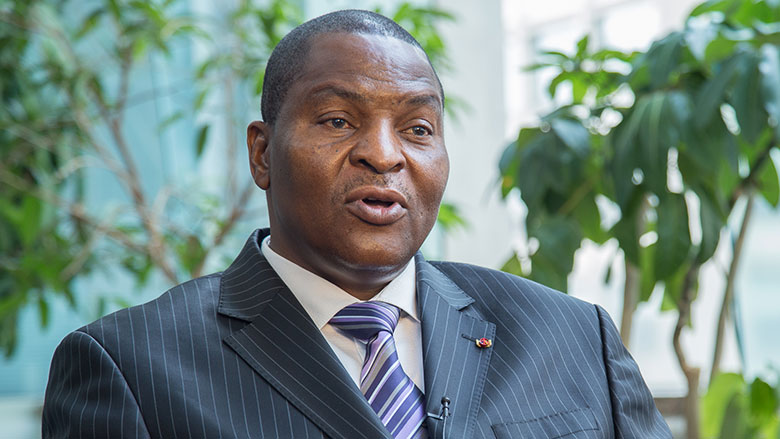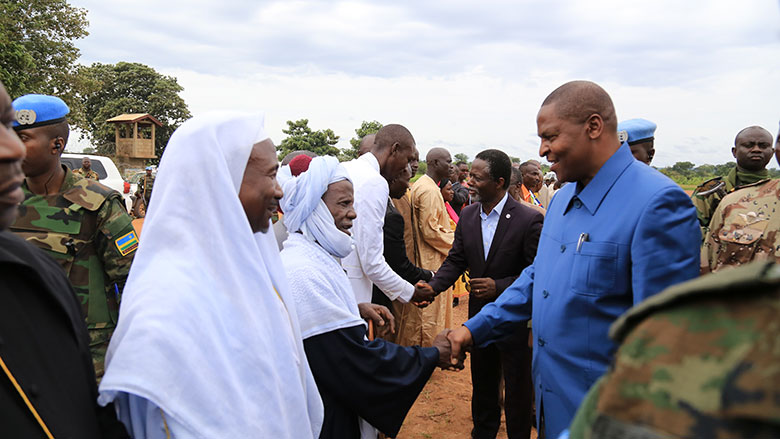Building a better future
About 2.3 million people, around half of the country’s population, are still in urgent need of humanitarian assistance. But the country is rich in natural resources. With plenty of water and arable land, these citizens can rebuild their lives and become food secure. By working to diversify the extractives industry and developing its agriculture sector, the CAR could drive its economy. But it will take commitment from the international community: commitment that goes beyond stabilization efforts and humanitarian aid.
“We must ensure that that our farmers get back to work,” said President Touadéra in his recent interview. “Many persons were displaced as a result of the crisis. The people can no longer go to the fields. A disarmament program will, I believe, restore peace and enable our farmers to resume their activities (…) In fact, 80% of our population lives in the countryside, where the main activity is agriculture. So, to promote agriculture means to help 80% of the population,” he added.
The World Bank Group is working with partners to ensure that this fragile and hard-won stability is lasting. “The organization of credible elections, the Government’s commitment to implement major reforms and the end of open conflicts have created a window of opportunity to break the fragility trap,” said Paul Noumba Um, the World Bank Country Director for the Central African Republic, Mali, Niger, Chad and Guinea.
The World Bank has recently approved an ambitious USD 250 million program over the next three years through its IDA Turnaround facility, which includes 11 projects combining stabilization and development efforts. “It’s five times higher than the regular allocation provided to the country by the International Development Association (IDA) and has been designed in close collaboration with the authorities and other donors,” noted Jean-Christophe Carret, the World Bank Country manager for the Central African Republic. “Our top 3 priorities are public finances management, reintegration of both former combatants and displaced population as well as job creation, through a large road reopening and agriculture program,” he said.
In addition, the WB is co-leading, alongside the UN and the EU, a Recovery and Peacebuilding Assessment (RPBA) — to define the country’s priorities over the short and medium term— and the preparation of an International Donor Conference for CAR which will take place in Brussels on November 17, 2016. The RPBA identifies urgent needs at USD 120 per capita per year, which equals more than doubling compared to actual aid provided in 2012.
According to Paul Noumba Um, “With our help, and strong coordination with other partners, the Central African Republic can become a post-conflict reconstruction success story. It will take continued effort to ensure peace and stability, but it is worth it.”
Building a better future
About 2.3 million people, around half of the country’s population, are still in urgent need of humanitarian assistance. But the country is rich in natural resources. With plenty of water and arable land, these citizens can rebuild their lives and become food secure. By working to diversify the extractives industry and developing its agriculture sector, the CAR could drive its economy. But it will take commitment from the international community: commitment that goes beyond stabilization efforts and humanitarian aid.
“We must ensure that that our farmers get back to work,” said President Touadéra in his recent interview. “Many persons were displaced as a result of the crisis. The people can no longer go to the fields. A disarmament program will, I believe, restore peace and enable our farmers to resume their activities (…) In fact, 80% of our population lives in the countryside, where the main activity is agriculture. So, to promote agriculture means to help 80% of the population,” he added.
The World Bank Group is working with partners to ensure that this fragile and hard-won stability is lasting. “The organization of credible elections, the Government’s commitment to implement major reforms and the end of open conflicts have created a window of opportunity to break the fragility trap,” said Paul Noumba Um, the World Bank Country Director for the Central African Republic, Mali, Niger, Chad and Guinea.
The World Bank has recently approved an ambitious USD 250 million program over the next three years through its IDA Turnaround facility, which includes 11 projects combining stabilization and development efforts. “It’s five times higher than the regular allocation provided to the country by the International Development Association (IDA) and has been designed in close collaboration with the authorities and other donors,” noted Jean-Christophe Carret, the World Bank Country manager for the Central African Republic. “Our top 3 priorities are public finances management, reintegration of both former combatants and displaced population as well as job creation, through a large road reopening and agriculture program,” he said.
In addition, the WB is co-leading, alongside the UN and the EU, a Recovery and Peacebuilding Assessment (RPBA) — to define the country’s priorities over the short and medium term— and the preparation of an International Donor Conference for CAR which will take place in Brussels on November 17, 2016. The RPBA identifies urgent needs at USD 120 per capita per year, which equals more than doubling compared to actual aid provided in 2012.
According to Paul Noumba Um, “With our help, and strong coordination with other partners, the Central African Republic can become a post-conflict reconstruction success story. It will take continued effort to ensure peace and stability, but it is worth it.”
Building a better future
About 2.3 million people, around half of the country’s population, are still in urgent need of humanitarian assistance. But the country is rich in natural resources. With plenty of water and arable land, these citizens can rebuild their lives and become food secure. By working to diversify the extractives industry and developing its agriculture sector, the CAR could drive its economy. But it will take commitment from the international community: commitment that goes beyond stabilization efforts and humanitarian aid.
“We must ensure that that our farmers get back to work,” said President Touadéra in his recent interview. “Many persons were displaced as a result of the crisis. The people can no longer go to the fields. A disarmament program will, I believe, restore peace and enable our farmers to resume their activities (…) In fact, 80% of our population lives in the countryside, where the main activity is agriculture. So, to promote agriculture means to help 80% of the population,” he added.
The World Bank Group is working with partners to ensure that this fragile and hard-won stability is lasting. “The organization of credible elections, the Government’s commitment to implement major reforms and the end of open conflicts have created a window of opportunity to break the fragility trap,” said Paul Noumba Um, the World Bank Country Director for the Central African Republic, Mali, Niger, Chad and Guinea.
The World Bank has recently approved an ambitious USD 250 million program over the next three years through its IDA Turnaround facility, which includes 11 projects combining stabilization and development efforts. “It’s five times higher than the regular allocation provided to the country by the International Development Association (IDA) and has been designed in close collaboration with the authorities and other donors,” noted Jean-Christophe Carret, the World Bank Country manager for the Central African Republic. “Our top 3 priorities are public finances management, reintegration of both former combatants and displaced population as well as job creation, through a large road reopening and agriculture program,” he said.
In addition, the WB is co-leading, alongside the UN and the EU, a Recovery and Peacebuilding Assessment (RPBA) — to define the country’s priorities over the short and medium term— and the preparation of an International Donor Conference for CAR which will take place in Brussels on November 17, 2016. The RPBA identifies urgent needs at USD 120 per capita per year, which equals more than doubling compared to actual aid provided in 2012.
According to Paul Noumba Um, “With our help, and strong coordination with other partners, the Central African Republic can become a post-conflict reconstruction success story. It will take continued effort to ensure peace and stability, but it is worth it.”
Building a better future
About 2.3 million people, around half of the country’s population, are still in urgent need of humanitarian assistance. But the country is rich in natural resources. With plenty of water and arable land, these citizens can rebuild their lives and become food secure. By working to diversify the extractives industry and developing its agriculture sector, the CAR could drive its economy. But it will take commitment from the international community: commitment that goes beyond stabilization efforts and humanitarian aid.
“We must ensure that that our farmers get back to work,” said President Touadéra in his recent interview. “Many persons were displaced as a result of the crisis. The people can no longer go to the fields. A disarmament program will, I believe, restore peace and enable our farmers to resume their activities (…) In fact, 80% of our population lives in the countryside, where the main activity is agriculture. So, to promote agriculture means to help 80% of the population,” he added.
The World Bank Group is working with partners to ensure that this fragile and hard-won stability is lasting. “The organization of credible elections, the Government’s commitment to implement major reforms and the end of open conflicts have created a window of opportunity to break the fragility trap,” said Paul Noumba Um, the World Bank Country Director for the Central African Republic, Mali, Niger, Chad and Guinea.
The World Bank has recently approved an ambitious USD 250 million program over the next three years through its IDA Turnaround facility, which includes 11 projects combining stabilization and development efforts. “It’s five times higher than the regular allocation provided to the country by the International Development Association (IDA) and has been designed in close collaboration with the authorities and other donors,” noted Jean-Christophe Carret, the World Bank Country manager for the Central African Republic. “Our top 3 priorities are public finances management, reintegration of both former combatants and displaced population as well as job creation, through a large road reopening and agriculture program,” he said.
In addition, the WB is co-leading, alongside the UN and the EU, a Recovery and Peacebuilding Assessment (RPBA) — to define the country’s priorities over the short and medium term— and the preparation of an International Donor Conference for CAR which will take place in Brussels on November 17, 2016. The RPBA identifies urgent needs at USD 120 per capita per year, which equals more than doubling compared to actual aid provided in 2012.
According to Paul Noumba Um, “With our help, and strong coordination with other partners, the Central African Republic can become a post-conflict reconstruction success story. It will take continued effort to ensure peace and stability, but it is worth it.”


